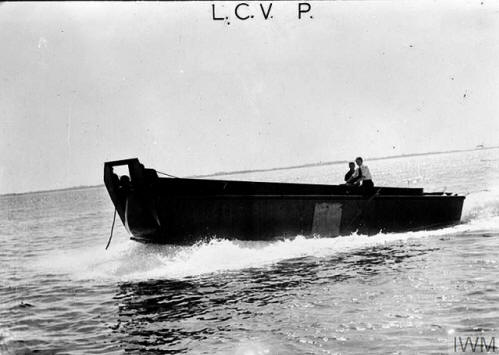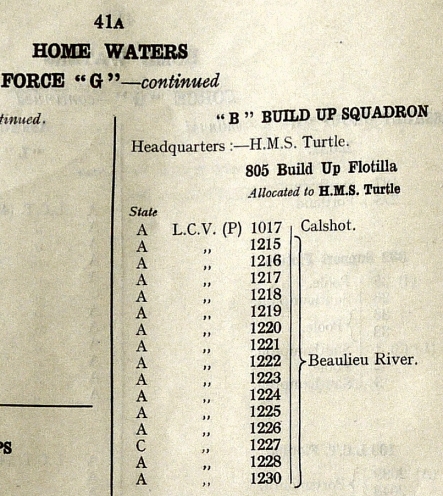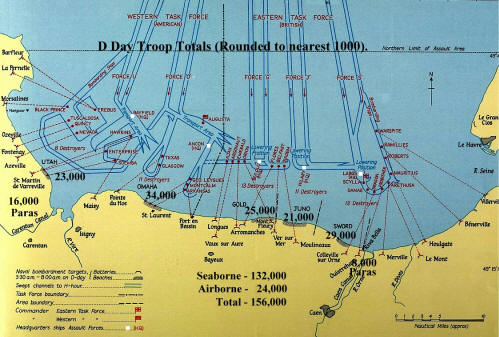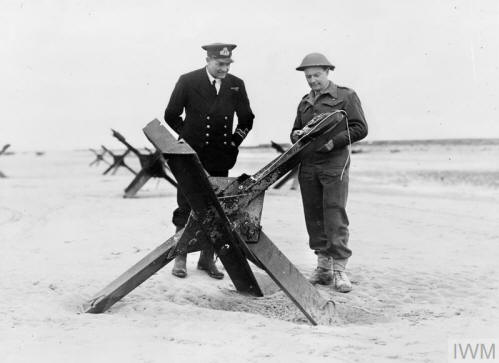|
Landing Craft Vehicle (Personnel) 1228 on D Day.
805 Build Up Flotilla

Background
LCV(P) 1228,
(Landing Craft
Vehicle (Personnel), was a small flat bottomed vessel, whose primary function in WW2 was to deliver
a few armed vehicles or 30+ fully armed troops onto unimproved, enemy held
beaches. There were many hundreds of these craft involved in Operation
Neptune, the amphibious phase of Operation Overlord.
This is an account of the
short life and brutal end of LCV(P) 1228
and her crew.
[Photo; A Landing Craft
Vehicle (Personnel).
© IWM (A 24664)].
LCV(P) 1228 was built in the
closing months of 1943 at one of hundreds of small boatyards around
Britain's coastline. She was received by the navy in February 1944 and
taken into service with the newly formed 805 Flotilla, working out of Itchener in Chichester harbour.
After
several months of intensive training, including full scale exercises in
the English Channel, 805 Flotilla, then comprising sixteen craft, joined
four other similar flotillas collectively
known as B Squadron. In May, 1944, as D-Day approached, they moved to their operational base at Exbury on the
Beaulieu River. There, they undertook a couple of weeks 'shaking down'
exercises, after which the Squadron sailed into the Solent to join the great Armada at 22.00 hrs on June 5th.
 LCV(P) 1228's crew comprised 1
coxswain, 1 stoker/driver and 1 signals/deckhand. It was 36 feet long and
10 ft 6 inches in beam with an un-laden weight of around 8 tons and up to11.5 tons
laden. It was constructed mainly of half inch plywood with an outer
shield of half inch steel plating to protect the freeboard. It had a very
shallow draught of 3 feet astern and 18 inches forward and was powered by a 235 bhp diesel engine with a range of 102 miles. Its armament
comprised 2 x .303 calibre Lewis machine guns. LCV(P) 1228's crew comprised 1
coxswain, 1 stoker/driver and 1 signals/deckhand. It was 36 feet long and
10 ft 6 inches in beam with an un-laden weight of around 8 tons and up to11.5 tons
laden. It was constructed mainly of half inch plywood with an outer
shield of half inch steel plating to protect the freeboard. It had a very
shallow draught of 3 feet astern and 18 inches forward and was powered by a 235 bhp diesel engine with a range of 102 miles. Its armament
comprised 2 x .303 calibre Lewis machine guns.
[An extract from the Admiralty's 'Green
List' showing the disposition of the 805 Build Up Flotilla].
Unlike many other similar sized
assault craft, such as the Landing Craft Assault (LCA), LCV(P)s were not transported to the
landing beaches on mother ships. They made their own way under their own
power. The distance to be covered from the Beaulieu River to Le Hamel in
Normandy was around 90 nautical miles. With a top speed of 9 knots, transporting 36 fully
armed troops across that distance was untenable, particularly in rough
conditions. The planners decided instead, that each craft would carry 100
(200?) five gallon jerry cans of petrol to supply the tanks and lorries in
support of the advancing troops.
Channel Crossing
For a while, the Flotilla ran an
easterly course through the darkness of the Solent, making contact with their main group, Force "G" (Gold
Beach), three miles north of the Nab Tower. At
approximately 0200 hrs on June 6th, they weighed anchor and headed south
towards Normandy. By this time, paratroops and the seaborne initial
assault troops were well on their way to Normandy.
Any anxiety or trepidation
the 3 man crew of LCV(P) 1228 felt soon gave way to the more pressing
concern of survival. As they headed out into the open sea, cross currents and force 4/5 south westerly
winds created troubled waters of short, sharp waves. They caused the flat bottomed craft
to slip and slide through an unremitting series of troughs and
crests. As each succeeding wave slapped hard into the landing ramp, the
relentless wind exploded the grey green-water into thousands of ice cold
stinging needles of spray that swept over the boat from stem to stern.
There was no cover for the crew.

It
was a long night fighting the elements to stay
afloat. The crew of 3 were soaking wet and chilled to the bone but the continuous roar of unseen
Allied aircraft overhead provided some comfort to them. They were
particularly vulnerable to squirts of incendiary cannon
shells from the Luftwaffe, because of their their highly volatile cargo.
The very thought induced a stomach churning fear.
After about 9 hours, they
arrived off Gold beach in line with the plan. On the run in, they passed battleships, cruisers and destroyers
firing salvos to predetermined targets on and around the landing beaches
while, inshore, rocket and flak ships joined the melee. The LCV(P)s
continued on their approach to Jig
Sector of Gold Beach.
It was a scene of utter chaos.
The Landings
Avoiding the multitude of German beach
obstacles, damaged and sunken landing craft, submerged DD Tanks (floating
tanks that didn't make it to the beach) and the ghastly debris of the
initial assault, 1228's landing ramp finally touched sand.
As the pounding surf swung the stern around, it
was only the expertise of the crew that prevented the craft from 'broaching to'
and becoming a serious liability on the beach - stuck fast on a falling tide. Quickly unloading
and being summarily dismissed by an overworked beach master, who invited
them to "Get off my bloody beach!", 1228 kedged off and headed for open
water.
 Standing a few miles
offshore were half a dozen Empire Class liberty ships, loaded to the gunwales with thousands of troops.
The High Command, anxious to get the men ashore, ordered the LCVPs to
assist in this. 1288 drew alongside one
of the troop ships as the coxswain frantically tried to prevent his
craft from smashing into the ship's side. The swell was lifting and dropping the craft 20 to 30 feet every few seconds. Standing a few miles
offshore were half a dozen Empire Class liberty ships, loaded to the gunwales with thousands of troops.
The High Command, anxious to get the men ashore, ordered the LCVPs to
assist in this. 1288 drew alongside one
of the troop ships as the coxswain frantically tried to prevent his
craft from smashing into the ship's side. The swell was lifting and dropping the craft 20 to 30 feet every few seconds.
[Photo;
Lieutenant Commander J C Haans Hamilton, RNVR, and Major Clayton,
Royal Engineers, studying one of the obstacles with attached mines at low tides.
© IWM (A 23991)].
Fully
armed troops proceeded to climb down the scrambling nets over the side of
the troop carrying ship, many suffering injuries as they tried to embark
the heaving landing craft. Wet through and in many cases violently sick,
the troops then endured a horrendously uncomfortable 3 mile journey to the
landing beach. Throughout the afternoon and evening, the surviving craft
of 805 Flotilla maintained a continuous shuttle
service from ship to shore. Only the onset of darkness brought the frantic day to
an end.
1228 and the other surviving
craft of 805 Squadron dropped anchor or
tied up alongside the larger craft and tried to rest, while they waited for the next phase to begin.
Years of frustration at the lack of opportunity to strike back at the
German forces was dramatically relieved, as the first of many air raid
alerts sounded. Every man jack of the Allied Forces pointed his firearm
skywards and blasted off! It must have been a formidable, intimidating
sight for Luftwaffe fighter/bomber pilots, as they risked all to bomb and strafe the beachheads and shipping.
The
craft of 805 Flotilla opted to spend the hours of darkness
clustered around HMS Bulolo, like chicks around the mother hen. Bulolo was
the HQ ship for the Gold Beach assault and, as such, carried more than her
fair share of senior officers from the 3 services and executive personnel.
It was not unreasonable to take some comfort from the thousands of targets
available to the incoming Luftwaffe pilots, who employed hit and run
tactics. With an ear splitting roar, several Messershmitts streaked across the anchorage. A
lethal cocktail of high
explosives, anti-personnel (AP) and phosphorous bombs, smacked hard into
Bulolo with devastating effect. Shards of red hot metal ricocheted off
the ship, while AP bombs hurtled towards the landing craft
creating havoc.
Under the flickering light
from the ships on fire and some emergency lighting, the stern of 1228
was seen to rear out of the turbulent water, its brilliant capital "G"
pointing skywards, while the heavy steel landing ramps forced its bow deep below
the murky waters. A little more than 24 hours
after proudly taking the salute from the Captain and staff of HMS
Mastodon lined up on the Exbury jetty, having subsequently survived
the arduous Channel crossing, having safely delivered their volatile cans
of petrol and countless troops and supplies to the landing beaches, the
smashed and battered hulk of 1228 was, unceremoniously, towed away. She
was beached to join hundreds of other small
landing craft in one of the many ships' graveyards along the Normandy
coast.
The Aftermath
The planners estimated a
casualty rate of around 30% for the first day. Thankfully, overall losses
were below that figure but, for LCV(P) 1228, the losses were of a different
magnitude. Two of the three
crew were killed. Throughout naval history, the role of large naval vessels
in battle has
been well documented but there are countless untold stories of
the thousands of little ships of many types, which remain to be told. The LCV(P) Flotillas were, arguably, the smallest craft to make
the 90 mile passage to Normandy under their own power. Their valuable
contribution to the greatest amphibious invasion force in history
deserves to be remembered.
Survivor, Robert Purdom,
did not escape the bombing raid unscathed. He lost his sight in one eye
and sustained a shrapnel wound to his shoulder. He was transferred to a
hospital ship and later back home to the UK for further care. Like many
who witnessed the unimaginable in war, he never talked much about his
experiences, although the painful memories would no doubt be difficult to
expunge. His grandson, Scott, said of his grandfather "he was a very
humble and funny man who never complained about his injuries and told me lots of
funny stories." He crossed the bar, suddenly, on the 7th June, 2009, almost
65 years to the hour after the horrific events described here.
Further Reading
On this
website there are around 50 accounts of
landing craft training and
operations and landing craft
training establishments.
There are around 300 books listed on
our 'Combined Operations Books' page which can be purchased on-line from
the Advanced Book Exchange (ABE) whose search banner checks the shelves of
thousands of book shops world-wide. Type in or copy and paste the title of
your choice or use the 'keyword' box for book suggestions. There's no
obligation to buy, no registration and no passwords. Click
'Books' for more
information.
 Acknowledgments Acknowledgments
This account of
LCV(P) 1228 was written by Mr Ray Knapp ex Royal Marine Corporal (Coxswain) for his
friend and comrade Robert S Purdom, who served as Coxswain on the craft
and was the only survivor from the 3 man crew.
|

 LCV(P) 1228's crew comprised 1
coxswain, 1 stoker/driver and 1 signals/deckhand. It was 36 feet long and
10 ft 6 inches in beam with an un-laden weight of around 8 tons and up to11.5 tons
laden. It was constructed mainly of half inch plywood with an outer
shield of half inch steel plating to protect the freeboard. It had a very
shallow draught of 3 feet astern and 18 inches forward and was powered by a 235 bhp diesel engine with a range of 102 miles. Its armament
comprised 2 x .303 calibre Lewis machine guns.
LCV(P) 1228's crew comprised 1
coxswain, 1 stoker/driver and 1 signals/deckhand. It was 36 feet long and
10 ft 6 inches in beam with an un-laden weight of around 8 tons and up to11.5 tons
laden. It was constructed mainly of half inch plywood with an outer
shield of half inch steel plating to protect the freeboard. It had a very
shallow draught of 3 feet astern and 18 inches forward and was powered by a 235 bhp diesel engine with a range of 102 miles. Its armament
comprised 2 x .303 calibre Lewis machine guns.


